Md Tahmid Rahman Laskar
When Can We Trust LLMs in Mental Health? Large-Scale Benchmarks for Reliable LLM Evaluation
Oct 21, 2025Abstract:Evaluating Large Language Models (LLMs) for mental health support is challenging due to the emotionally and cognitively complex nature of therapeutic dialogue. Existing benchmarks are limited in scale, reliability, often relying on synthetic or social media data, and lack frameworks to assess when automated judges can be trusted. To address the need for large-scale dialogue datasets and judge reliability assessment, we introduce two benchmarks that provide a framework for generation and evaluation. MentalBench-100k consolidates 10,000 one-turn conversations from three real scenarios datasets, each paired with nine LLM-generated responses, yielding 100,000 response pairs. MentalAlign-70k}reframes evaluation by comparing four high-performing LLM judges with human experts across 70,000 ratings on seven attributes, grouped into Cognitive Support Score (CSS) and Affective Resonance Score (ARS). We then employ the Affective Cognitive Agreement Framework, a statistical methodology using intraclass correlation coefficients (ICC) with confidence intervals to quantify agreement, consistency, and bias between LLM judges and human experts. Our analysis reveals systematic inflation by LLM judges, strong reliability for cognitive attributes such as guidance and informativeness, reduced precision for empathy, and some unreliability in safety and relevance. Our contributions establish new methodological and empirical foundations for reliable, large-scale evaluation of LLMs in mental health. We release the benchmarks and codes at: https://github.com/abeerbadawi/MentalBench/
Evolution of ReID: From Early Methods to LLM Integration
Jun 16, 2025Abstract:Person re-identification (ReID) has evolved from handcrafted feature-based methods to deep learning approaches and, more recently, to models incorporating large language models (LLMs). Early methods struggled with variations in lighting, pose, and viewpoint, but deep learning addressed these issues by learning robust visual features. Building on this, LLMs now enable ReID systems to integrate semantic and contextual information through natural language. This survey traces that full evolution and offers one of the first comprehensive reviews of ReID approaches that leverage LLMs, where textual descriptions are used as privileged information to improve visual matching. A key contribution is the use of dynamic, identity-specific prompts generated by GPT-4o, which enhance the alignment between images and text in vision-language ReID systems. Experimental results show that these descriptions improve accuracy, especially in complex or ambiguous cases. To support further research, we release a large set of GPT-4o-generated descriptions for standard ReID datasets. By bridging computer vision and natural language processing, this survey offers a unified perspective on the field's development and outlines key future directions such as better prompt design, cross-modal transfer learning, and real-world adaptability.
Judging the Judges: Can Large Vision-Language Models Fairly Evaluate Chart Comprehension and Reasoning?
May 13, 2025Abstract:Charts are ubiquitous as they help people understand and reason with data. Recently, various downstream tasks, such as chart question answering, chart2text, and fact-checking, have emerged. Large Vision-Language Models (LVLMs) show promise in tackling these tasks, but their evaluation is costly and time-consuming, limiting real-world deployment. While using LVLMs as judges to assess the chart comprehension capabilities of other LVLMs could streamline evaluation processes, challenges like proprietary datasets, restricted access to powerful models, and evaluation costs hinder their adoption in industrial settings. To this end, we present a comprehensive evaluation of 13 open-source LVLMs as judges for diverse chart comprehension and reasoning tasks. We design both pairwise and pointwise evaluation tasks covering criteria like factual correctness, informativeness, and relevancy. Additionally, we analyze LVLM judges based on format adherence, positional consistency, length bias, and instruction-following. We focus on cost-effective LVLMs (<10B parameters) suitable for both research and commercial use, following a standardized evaluation protocol and rubric to measure the LVLM judge's accuracy. Experimental results reveal notable variability: while some open LVLM judges achieve GPT-4-level evaluation performance (about 80% agreement with GPT-4 judgments), others struggle (below ~10% agreement). Our findings highlight that state-of-the-art open-source LVLMs can serve as cost-effective automatic evaluators for chart-related tasks, though biases such as positional preference and length bias persist.
ChartQAPro: A More Diverse and Challenging Benchmark for Chart Question Answering
Apr 10, 2025Abstract:Charts are ubiquitous, as people often use them to analyze data, answer questions, and discover critical insights. However, performing complex analytical tasks with charts requires significant perceptual and cognitive effort. Chart Question Answering (CQA) systems automate this process by enabling models to interpret and reason with visual representations of data. However, existing benchmarks like ChartQA lack real-world diversity and have recently shown performance saturation with modern large vision-language models (LVLMs). To address these limitations, we introduce ChartQAPro, a new benchmark that includes 1,341 charts from 157 diverse sources, spanning various chart types, including infographics and dashboards, and featuring 1,948 questions in various types, such as multiple-choice, conversational, hypothetical, and unanswerable questions, to better reflect real-world challenges. Our evaluations with 21 models show a substantial performance drop for LVLMs on ChartQAPro; e.g., Claude Sonnet 3.5 scores 90.5% on ChartQA but only 55.81% on ChartQAPro, underscoring the complexity of chart reasoning. We complement our findings with detailed error analyses and ablation studies, identifying key challenges and opportunities for advancing LVLMs in chart understanding and reasoning. We release ChartQAPro at https://github.com/vis-nlp/ChartQAPro.
DataNarrative: Automated Data-Driven Storytelling with Visualizations and Texts
Aug 13, 2024



Abstract:Data-driven storytelling is a powerful method for conveying insights by combining narrative techniques with visualizations and text. These stories integrate visual aids, such as highlighted bars and lines in charts, along with textual annotations explaining insights. However, creating such stories requires a deep understanding of the data and meticulous narrative planning, often necessitating human intervention, which can be time-consuming and mentally taxing. While Large Language Models (LLMs) excel in various NLP tasks, their ability to generate coherent and comprehensive data stories remains underexplored. In this work, we introduce a novel task for data story generation and a benchmark containing 1,449 stories from diverse sources. To address the challenges of crafting coherent data stories, we propose a multiagent framework employing two LLM agents designed to replicate the human storytelling process: one for understanding and describing the data (Reflection), generating the outline, and narration, and another for verification at each intermediary step. While our agentic framework generally outperforms non-agentic counterparts in both model-based and human evaluations, the results also reveal unique challenges in data story generation.
A Systematic Survey and Critical Review on Evaluating Large Language Models: Challenges, Limitations, and Recommendations
Jul 04, 2024



Abstract:Large Language Models (LLMs) have recently gained significant attention due to their remarkable capabilities in performing diverse tasks across various domains. However, a thorough evaluation of these models is crucial before deploying them in real-world applications to ensure they produce reliable performance. Despite the well-established importance of evaluating LLMs in the community, the complexity of the evaluation process has led to varied evaluation setups, causing inconsistencies in findings and interpretations. To address this, we systematically review the primary challenges and limitations causing these inconsistencies and unreliable evaluations in various steps of LLM evaluation. Based on our critical review, we present our perspectives and recommendations to ensure LLM evaluations are reproducible, reliable, and robust.
Are Large Vision Language Models up to the Challenge of Chart Comprehension and Reasoning? An Extensive Investigation into the Capabilities and Limitations of LVLMs
Jun 01, 2024


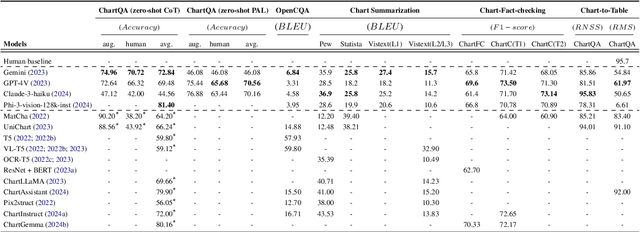
Abstract:Natural language is a powerful complementary modality of communication for data visualizations, such as bar and line charts. To facilitate chart-based reasoning using natural language, various downstream tasks have been introduced recently such as chart question answering, chart summarization, and fact-checking with charts. These tasks pose a unique challenge, demanding both vision-language reasoning and a nuanced understanding of chart data tables, visual encodings, and natural language prompts. Despite the recent success of Large Language Models (LLMs) across diverse NLP tasks, their abilities and limitations in the realm of data visualization remain under-explored, possibly due to their lack of multi-modal capabilities. To bridge the gap, this paper presents the first comprehensive evaluation of the recently developed large vision language models (LVLMs) for chart understanding and reasoning tasks. Our evaluation includes a comprehensive assessment of LVLMs, including GPT-4V and Gemini, across four major chart reasoning tasks. Furthermore, we perform a qualitative evaluation of LVLMs' performance on a diverse range of charts, aiming to provide a thorough analysis of their strengths and weaknesses. Our findings reveal that LVLMs demonstrate impressive abilities in generating fluent texts covering high-level data insights while also encountering common problems like hallucinations, factual errors, and data bias. We highlight the key strengths and limitations of chart comprehension tasks, offering insights for future research.
Query-OPT: Optimizing Inference of Large Language Models via Multi-Query Instructions in Meeting Summarization
Feb 29, 2024
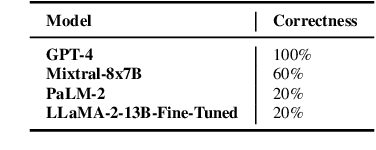


Abstract:This work focuses on the task of query-based meeting summarization in which the summary of a context (meeting transcript) is generated in response to a specific query. When using Large Language Models (LLMs) for this task, a new call to the LLM inference endpoint/API is required for each new query even if the context stays the same. However, repeated calls to the LLM inference endpoints would significantly increase the costs of using them in production, making LLMs impractical for many real-world use cases. To address this problem, in this paper, we investigate whether combining the queries for the same input context in a single prompt to minimize repeated calls can be successfully used in meeting summarization. In this regard, we conduct extensive experiments by comparing the performance of various popular LLMs: GPT-4, PaLM-2, LLaMA-2, Mistral, and FLAN-T5 in single-query and multi-query settings. We observe that while most LLMs tend to respond to the multi-query instructions, almost all of them (except GPT-4), even after fine-tuning, could not properly generate the response in the required output format. We conclude that while multi-query prompting could be useful to optimize the inference costs by reducing calls to the inference endpoints/APIs for the task of meeting summarization, this capability to reliably generate the response in the expected format is only limited to certain LLMs.
Tiny Titans: Can Smaller Large Language Models Punch Above Their Weight in the Real World for Meeting Summarization?
Feb 01, 2024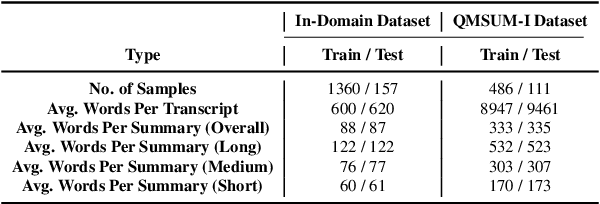

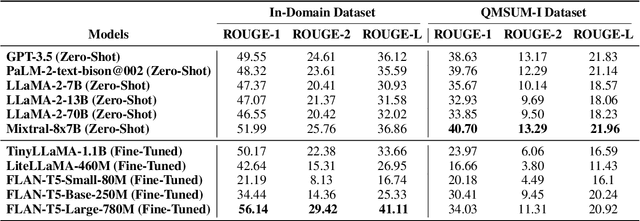

Abstract:Large Language Models (LLMs) have demonstrated impressive capabilities to solve a wide range of tasks without being explicitly fine-tuned on task-specific datasets. However, deploying LLMs in the real world is not trivial, as it requires substantial computing resources. In this paper, we investigate whether smaller, compact LLMs are a good alternative to the comparatively Larger LLMs2 to address significant costs associated with utilizing LLMs in the real world. In this regard, we study the meeting summarization task in a real-world industrial environment and conduct extensive experiments by comparing the performance of fine-tuned compact LLMs (e.g., FLAN-T5, TinyLLaMA, LiteLLaMA) with zero-shot larger LLMs (e.g., LLaMA-2, GPT-3.5, PaLM-2). We observe that most smaller LLMs, even after fine-tuning, fail to outperform larger zero-shot LLMs in meeting summarization datasets. However, a notable exception is FLAN-T5 (780M parameters), which performs on par or even better than many zero-shot Larger LLMs (from 7B to above 70B parameters), while being significantly smaller. This makes compact LLMs like FLAN-T5 a suitable cost-efficient solution for real-world industrial deployment.
Building Real-World Meeting Summarization Systems using Large Language Models: A Practical Perspective
Nov 08, 2023

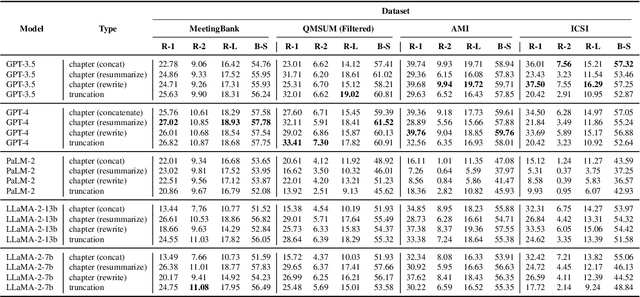
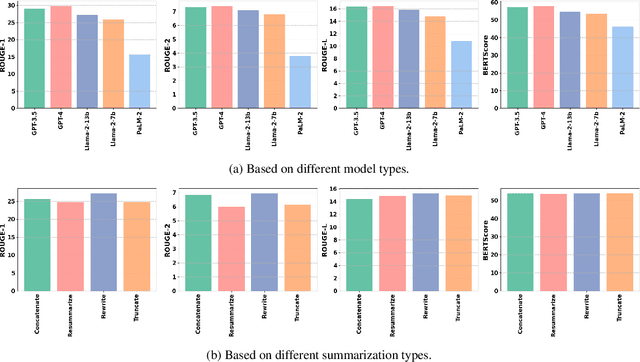
Abstract:This paper studies how to effectively build meeting summarization systems for real-world usage using large language models (LLMs). For this purpose, we conduct an extensive evaluation and comparison of various closed-source and open-source LLMs, namely, GPT-4, GPT- 3.5, PaLM-2, and LLaMA-2. Our findings reveal that most closed-source LLMs are generally better in terms of performance. However, much smaller open-source models like LLaMA- 2 (7B and 13B) could still achieve performance comparable to the large closed-source models even in zero-shot scenarios. Considering the privacy concerns of closed-source models for only being accessible via API, alongside the high cost associated with using fine-tuned versions of the closed-source models, the opensource models that can achieve competitive performance are more advantageous for industrial use. Balancing performance with associated costs and privacy concerns, the LLaMA-2-7B model looks more promising for industrial usage. In sum, this paper offers practical insights on using LLMs for real-world business meeting summarization, shedding light on the trade-offs between performance and cost.
 Add to Chrome
Add to Chrome Add to Firefox
Add to Firefox Add to Edge
Add to Edge